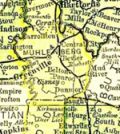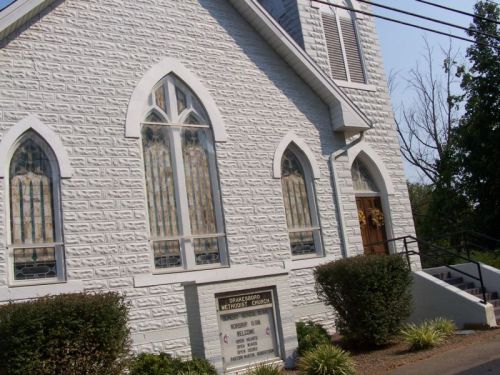Muhlenberg County Kentucky

Church Records
Drakesboro United Methodist Church
Photo contributed by Roberta Smith
- History
- Register
History
The first place of worship for the Drakesboro Methodist Church was the second school house of Main Street, which was built in 1884. The pastor was Rev. James T. Rusing from 1884 to 1886.
The second place of worship was a building owned by John R. Drake, formerly used as a commissary by the milling companies. It stood a little north of the depot and faced south. In the summer of 1891 a new frame building was constructed by the Methodists on one of the two lots, which were given to the church by John R. Drake and his wife. The lot used for the church was on the corner of Main and Third Streets. The parsonage lot adjoined the church lot and faced Main Street. Mr. John R. Drake not only contributed the lots but also helped substantially on the church building.
The new church was a frame building thirty feet wide and sixty feet long. A reed organ was used throughout the twenty-five years this building was in use. This building was razed to make room for the present structure.
The cornerstone was laid in 1919, and the basement was used for services while construction was going on. The concrete blocks were hand made on the site by Mr. Tom Perkins and his two sons. Our special appreciation is for the beautiful stained glass windows.
Rev. C.C. Jones became pastor in 1920. The ball was started rolling by a pledge of $1,500 by the Black Diamond Coal Mining Company. When Rev. C.C. Jones became pastor in 1920 there was a membership of seventy-two. When he left in 1924, the membership had grown to two hundred and fifty two.
When the church was dedicated by Bishop U.V.W. Darlington in September 1923, all indebtedness had been paid and there was money left over to start building the parsonage.
When the Drakesboro School House burned in 1925, the church basement became a classroom for more than two years while the new school was being constructed.
Most of our best memories are those that influenced our lives when we were very young. Our church was always a busy place. Something was always going on. We had ice cream suppers, oyster suppers, and chicken suppers. I learned to cook oysters watching Mr. Oscar (Peggy) Nelson cook them in the church kitchen.
When Rev. Felix Sanders was pastor from 1925 to 1927, pictures were made of all the Sunday school and of the separate Sunday School Classes. We do not have figures for every class, but the Junior Girls Class, taught by Miss Nell Jones, had eighteen members. The Junior Boys Class, taught by Brother Sanders, had eighteen members. The Men's Bible class had sixty-three members.
We wish to pay a special tribute to Miss Nell Jones. For fifty years she was our faithful organist and pianist, attending with the regularity of the pastor himself. Never to miss a service, day or night, through sunshine or rain, snow or sleet, summer or winter is a record unparalleled in the annals of any church history.
Not only this, but Miss Nell taught the Junior Girls Sunday School Class for many years, and a very interesting and inspiring teacher she was. She was also responsible for innumerable church programs. We had very elaborate programs for any and all occasions. Miss Nell planned and supervised these programs and financed the elaborate costumes. She also planned and supervised innumerable parties and banquets for the young people in the church basement. Miss Nell, we salute you!
Another person who was very influential at this time was Mr. J.R. (Bud) Kimmel. He taught the Intermediate Sunday School Class for many years. His specialties were picnics and hay rides, which were thoroughly enjoyed. Also, he used to stand at the front of the church and direct us as we marched around the sanctuary, singing “Onward Christian Soldiers.”
Mrs. Bertha Stewart taught the Young Ladies Sunday School Class for many years, along with various other activities, especially her work with the Women's Society. I remember a quilt they once made, called a “friendship” quilt. Everyone paid ten cents to have their names put on the quilt. The women embroidered the names and quilted the quilt. Dr. H.D. Newman bought the quilt, and then gave it back to the church with the stipulation that it should be left in the parsonage. I wonder whatever became of it!
One memory firmly implanted is of Mrs. Sally Drake Issac, daughter of John R. Drake. She was soloist for our church for many years. Her favorite song was “His Eye is on the Sparrow,” which she sang beautifully and often.
Mr. John Pierce Jones acted as Superintendent of our Sunday school for many years, handled business transactions and participated in all church activities. Mr. Jones was followed by Philip Cornette, who served as superintendent for seventeen years, as well as participating in all other church activities.
The young people had a very active and interesting Epworth League. Two people who were active sponsors of the Epworth League were J.A. Wright, principal of the Drakesboro High School, and Fannie Holland, high school English teacher. We often went on outings, which we called wiener roasts and marshmallow toasts. Ike Everly and Mose Rager would take along their guitars and we would all sit around the fire and sing. The Baptist church had BYPU on Sunday night, and Epworth League met on Wednesday night. On Sunday all the Methodists went to BYPU, and on Wednesday the Baptists came to Epworth League.
In later years Ike Everly performed before the Queen of England and Mose Rager performed twice at the Smithsonian Institute in Washington, D.C.
Two members of the Drakesboro Methodist Church became Methodist ministers. They were Doyle Robert Gant and Carl Truman Davis. Rev. Gant pastored in the Louisville Conference for many years. Carl T. Davis became an evangelist and served a wide area. He once held a revival in our church.
Mr. James Pellow taught the Adult Bible Class and sang in the choir for many years. He also taught study courses and led prayer meetings.
Ruth Webb attended our church as a child, then her family moved to Detroit, Michigan. Later Ruth became a missionary to Africa. She has recently retired and returned home to this country after thirty years as a missionary to Africa.
On October 8, 1982, because of the sinking of an old abandoned coalmine under the church, the walls of our church were badly broken. Fortunately, we were able to remove all furniture from the building before it was condemned. As luck would have it, the school had recently built a new lunchroom. The old lunchroom was vacant and unused. All church furniture was moved into the old lunchroom, and services were held there for one and one half years while the church building was being repaired. The story was aired on TV all over the country, and we received generous donations from other churches, friends, and former members and even from people we did not know and had never seen, who had seen our story on television.
When repairs began, it was learned that Mr. Tom Perkins's son still has the molds used to make the concrete blocks for the original structure.
Remarkably, with all the breakage, repairs and rebuilding, not a stained glass window was broken. We were able to move back into our church in April 1984, and what a happy return it was!
Precious Memories! How they linger! Who could be more fortunate, to have been in close association with such marvelous people under such wonderful circumstances!
May God bless the Drakesboro Methodist church in the future as he has in the past, and may we all be as faithful and as dedicated as those before us.
Methodist Pastors of Drakesboro 1884-1984
South Carrolton & Drakesboro
- James T. Rushing 1884-1886
- Jacob L. Reid 1886-1890
- Samuel L. C. Coward 1890-1893
- Jacob L. Reid 1893-1894
- Robert D. Bennet 1894-1895
Lewisburg & Drakesboro
- Luther W. Browder 1895-1897
- Elias Smith 1897-1899
- Jefferson B. Adams 1899-1900
- J.L. Kilgore 1900-1901
- Richard T. McConnell 1901-1903
- J.C. Brandon 1903-1905
- James E. Lewis 1905-1908
- S.U. Turnipseed 1908-1909
- W.C. Hayes 1909-1910
- D.S. Campbell 1910- February 1912
Drakesboro
- Paul Shell Powell 1912-1915
- Frank E. Lewis 1915-1917
- Robert H. Roe 1917-1918
- A.H. Reynolds 1918-1920
- C.C. Jones 1920-1924
- Wade Hickerson 1924-1925
- Felix J. Sanders 1925-1927
- S.M. Bailey 1927-1928
- Ivan Allen 1928-1929
- W.H. Russell 1929-1929
- J.R. Randolph 1929-1930
- Porter Napier 1930-1931
- Felix J. Sanders 1931-1933
- O.T. Lee 1933-1934
- George S. Wood 1934-1938
- C.E. Perkins 1938-1939
- E. Sidney Moore 1939-1940
- Harry A. Pullen Sr. 1940-1942
- Henry W. Landreth 1942-1944
- Robert K. Hulse 1944-1946
- Vestie V. Capps 1946-1949
- Samuel A. Mathews 1949-1952
- Clyde Walker 1952-1953
- E.E. Hudson 1953-1956
- John Hamilton 1956-1956
- Douglas Wilson 1956-1961
- F.T. Goode 1961-1962
- H.R. Capshaw & Wife 1962-1964
- Stoy Geary 1964-1970
- Carvil Scott 1970-1973
- Oda Wright 1973-1978 (Drakesboro & Pleasant Hill)
- Carlos Coop 1978-1980
- William Dodson 1980-1983
- Billy Glover 1983-1984
- Hilda Bentley 1984-
Citation: Williams, Margaret Nell. “A History of Drakesboro Methodist Church: Centennial Celebration, 1884-1984.” Drakesboro, KY: Drakesboro United Methodist Church, 1984.
Found May 2009 in papers belonging to Golda Mae Cardwell Wilkins (1884-1985), wife of John L. Wilkins (1883-1954), both long-time members of Drakesboro Methodist Church.
Contributed by Wilkins granddaughters Frances R. Nelson Salyers and Jennifer S. Nelson Sweeney, whose Nelson and Griffith ancestors were also members of the church.
Related: Images
Updated January 1, 2017
